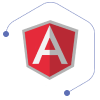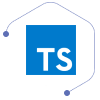- 34279, Duffy Terrace, Fremont California 94555
The part of a website that the user interacts with directly is termed the front end. It is also referred to as the ‘client side’ of the application. It includes everything that users experience directly: text colors and styles, images, graphs and tables, buttons, colors, and navigation menu. HTML, CSS, and JavaScript are the languages used for Front End development.
The structure, design, behavior, and content of everything seen on browser screens when websites, web applications, or mobile apps are opened up, is implemented by front End developers. Responsiveness and performance are two main objectives of the Front End. The developer must ensure that the site is responsive i.e. it appears correctly on devices of all sizes no part of the website should behave abnormally irrespective of the size of the screen. Always look for a good leading software development company.
Front-end Languages: The front-end portion is built by using some languages which are discussed below
- HTML: HTML stands for Hypertext Markup Language. It is used to design the front-end portion of web pages using a markup language. HTML is the combination of Hypertext and Markup language. Hypertext defines the link between the web pages. The markup language is used to define the text documentation within the tag which defines the structure of web pages.
- CSS: Cascading Style Sheets fondly referred to as CSS is a simply designed language intended to simplify the process of making web pages presentable. CSS allows you to apply styles to web pages. More importantly, CSS enables you to do this independent of the HTML that makes up each web page.
- JavaScript: JavaScript is a famous scripting language used to create magic on the sites to make the site interactive for the user. It is used to enhance the functionality of a website to run cool games and web-based software.
There are many other languages through which one can do front-end development depending upon the framework for example Flutter user Dart, React uses JavaScript and Django uses Python, and much more.
Back-End Development
The back-end is the server-side of the website. It stores and arranges data, and also makes sure everything on the client-side of the website works fine. This is the part of the website that you cannot see and interact with. It is the portion of software that does not come in direct contact with the users.
The parts and characteristics developed by backend designers are indirectly accessed by users through a front-end application. Activities, like writing APIs, creating libraries, and working with system components without user interfaces or even systems of scientific programming, are also included in the backend.

Back-end Languages: The back-end portion is built by using some languages which are discussed below:
- PHP: PHP is a server-side scripting language designed specifically for web development. Since PHP code is executed on the server-side, so it is called a server-side scripting language.
- C++: It is a general-purpose programming language and is widely used nowadays for competitive programming. It is also used as a backend language.
- Java: Java is one of the most popular and widely used programming languages and platforms. It is highly scalable. Java components are easily available.
- Python: Python is a programming language that lets you work quickly and integrate systems more efficiently.
- JavaScript: JavaScript can be used as both (front end and back end) programming languages.
- Node.js: Node.js is an open-source and cross-platform runtime environment for executing JavaScript code outside a browser. You need to remember that NodeJS is not a framework, and it’s not a programming language. Most people are confused and understand it’s a framework or a programming language. We often use Node.js for building back-end services like APIs like Web App or Mobile App. It’s used in production by large companies such as Paypal, Uber, Netflix, Walmart, and so on.
Read Here: 5 Effective Resource Management Strategies that Drive Productivity in 2021
Difference between Front-end and Back-end:
Front-end and back-end development are quite different from each other, but still, they are two aspects of the same situation. The front-end is what users see and interact with and the back-end is how everything works.
- The front-end is the part of the website users can see and interact with such as the graphical user interface (GUI) and the command line including the design, navigating menus, texts, images, videos, etc. Backend, on the contrary, is the part of the website users cannot see and interact with.
- The visual aspects of the website that can be seen and experienced by users are front-end. On the other hand, everything that happens in the background can be attributed to the backend.
- Languages used for the front-end are HTML, CSS, JavaScript while those used for the backend include Java, Ruby, Python, .Net.
We are a custom software development company based in Indore, India, specialized in providing technology services to clients around the globe. We have a pool of highly qualified resources in multiple technologies and platforms that can help you.

























